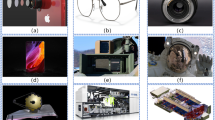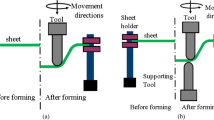Abstract
Using a modified Denavit–Hartenberg (D–H notation), we propose with this study a methodology for generating the wire-radius-compensated NC data equations required to carry out the machining of non-column workpieces on a five-axis wire-cut electrical discharge machine (WEDM). In the proposed approach, the designed surfaces of the machined component are constructed using a 4 × 4 homogeneous transformation matrix and ruled surfaces. The modified D–H notation is then employed to derive the machine’s ability matrix and to generate the desired wire location matrices. To ensure the precision of the machining operation, the wire location matrices are modulated by a novel effective-wire-radius compensation scheme. Finally, the NC data equations required to machine the component are derived by equating the ability matrix with the modulated wire location matrix. To validate the proposed methodology, three non-column workpieces with various top and bottom basic curves are machined on a commercial WEDM. The dimensions of the machined components are then compared with those of specimens machined using the built-in WEDM compensation scheme. The results show that the components manufactured using the proposed effective-wire-radius compensation scheme are more geometrically precise than those produced using the conventional WEDM compensation method.
Similar content being viewed by others
References
Denavit J, Hartenberg RS (1955) A kinematic notation for lower-pair mechanisms based on matrices. J App Mech—Trans ASME 77:215–221
Paul RP (1982) Robot manipulators—mathematics, programming and control. MIT Press, Cambridge
Denavit J, Hartenberg RS, Uicker JJ (1965) Velocity, acceleration, and static-force analysis of spatial linkages. J App Mech—Trans ASME 87:903–910
Dekeyser WL, Snoeys R (1989) Geometrical accuracy of WEDM. Proc ISEM 9 (Japan):226–232
McGeough JA (1988) Advanced methods of machining. Chapman and Hall, New York
Hsue AWJ, Su HC (2004) Removal analysis of WEDM’s tapering process and its application to generation of precise conjugate. J Mater Process Technol 149:117–123
Ravani B, Wang J (1991) Computer aided geometric of line constructs. J Mech Des—Trans ASME 113(4):363–371
Hocheng H, Lei WT, Hsu HS (1997) Preliminary study of material removal in electrical-discharge machining of SiC/ Al. J Mater Process Technol 63:813–818
Ni ZW, Liu ZX, Yu CY (1991) Intricate ruled surface machining by WEDM. J Mater Process Technol 28:169–175
Wang J, Ravani B (2003) Computer aided contouring operation for traveling wire electric discharge machining (EDM). Comput Aided Des 35(10):925–934
Yan HS, Lee RS, Yang YC (1995) An algorithm for surface design and tool path generation in wire-cut electrical discharge machining. Int J Mach Tools Manuf 35(12):1703–1714
Liu C, Esterling D (1997) Solid modeling of 4-axis wire EDM cut geometry. Comput Aided Des 29(12):803–810
Jian Z, Yu CY (1992) A new control strategy for sharp corner cutting in wire WDM. Proc ISEM 10 (Germany):353–358
Dauw DF (1994) High precision Wire-EDM by on-line wire position control. Ann CIRP 43(1):193–197
Lin PD, Chen JF (1994) Analysis of errors in precision closed-loop mechanisms. J Mech Des—Trans ASME 116(1):197–203
Author information
Authors and Affiliations
Corresponding author
Rights and permissions
About this article
Cite this article
Lin, P.D., Liao, TT. An effective-wire-radius compensation scheme for enhancing the precision of wire-cut electrical discharge machines. Int J Adv Manuf Technol 40, 324–331 (2009). https://doi.org/10.1007/s00170-007-1333-0
Received:
Accepted:
Published:
Issue Date:
DOI: https://doi.org/10.1007/s00170-007-1333-0




